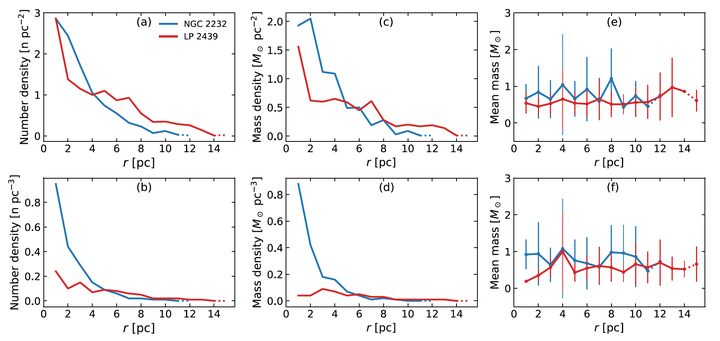Different Fates of Young Star Clusters After Gas Expulsion
 Image credit: Figure 5 in Pang et al. 2020. Number density, mass density, and mean mass distributions along a clustercentric distance r for NGC 2232 (blue curves) and LP 2439 (red curves).
Image credit: Figure 5 in Pang et al. 2020. Number density, mass density, and mean mass distributions along a clustercentric distance r for NGC 2232 (blue curves) and LP 2439 (red curves).
Abstract
We identify structures of the young star cluster NGC 2232 in the solar neighborhood (323.0 pc), and a newly discovered star cluster LP 2439 (289.1 pc). Member candidates are identified using the Gaia DR2 sky position, parallax and proper motion data, by an unsupervised machine learning method, \textsc{StarGO}. Member contamination from the Galactic disk is further removed using the color magnitude diagram. The four identified groups (NGC 2232, LP 2439 and two filamentary structures) of stars are coeval with an age of 25 Myr and were likely formed in the same giant molecular cloud. We correct the distance asymmetry from the parallax error with a Bayesian method. The 3D morphology shows the two spherical distributions of clusters NGC 2232 and LP 2439. Two filamentary structures are spatially and kinematically connected to NGC 2232. Both NGC 2232 and LP 2439 are expanding. The expansion is more significant in LP 2439, generating a loose spatial distribution with shallow volume number and mass density profiles. The expansion is suggested to be mainly driven by gas expulsion. NGC 2232, with 73~percent of the cluster mass bound, is currently experiencing a process of re-virialization, However, LP 2439, with 52 percent cluster mass being unbound, may fully dissolve in the near future. The different survivability traces different dynamical states of NGC 2232 and LP 2439 prior to the onset of gas expulsion. NGC 2232 may have been substructured and subvirial, while LP 2439 may either have been virial/supervirial, or it has experienced a much faster rate of gas removal.